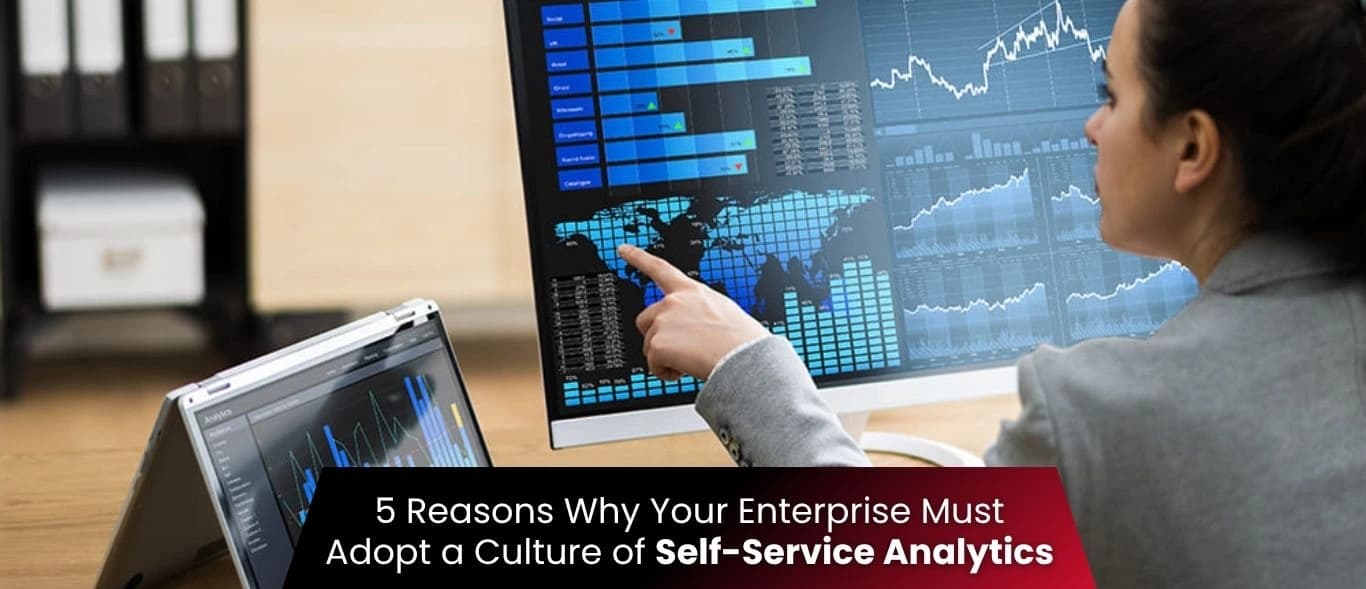If you want something done right, do it yourself – Anonymous. Readers of this blog would have, by now, grasped one fundamental aspect of data analytics: to adopt a culture of Self-Service Analytics fully, an organization needs two key elements – people and data.
This is true if your Enterprise continues to use traditional Business Intelligence (BI) tools. The same is also valid for self-service analytical tools, in fact, more so.
Reflect on the days when Information Technology (IT) was still a nascent industry. When computers were gigantic, spool-tape fed machines, occupying entire rooms, and not the micro version we see in everyone’s palms today, they were pretty different.
When hardware and software were not part of our daily vocabulary. How quickly things have changed. Today, even average households have at least one computer.
Data analytics is going down the IT road. The adoption rate may be slow, but disregard what pessimists say - self-service BI tools are here to stay.
This is a self-contained architecture of tools that enables even non-technical users to execute a full-spectrum analytic workflow independently.
The Very First Iteration: V-1
The very first iteration, V-1, which many organizations still deploy, involved the IT team analyzing the data and submitting the report to key business members.
Cumbersome, multi-page reports with charts and tables, which were seldom clearly understood. The key question, ‘why’, never seemed to be answered by them. That was the Paleolithic Period of data analytics.
Achieve business success with our data analytics consulting services >>>> Learn more
Second Iteration: V-2
Things started to look up after that; it had to, since the laws of evolution apply here, too. V-2 dawned when IT started empowering end-users – that guy in the black suit sitting in the corner office – to analyze the data for themselves, while the former continued to control the data sources and flow. BI started looking a little less technical, and the hazy figures began to come into focus.
In the interim, a new species emerged – the data analyst – who served as a liaison between IT personnel and top management. There was a problem – the two teams continued to work independently.
Why, for that matter, the C-Suite fellas themselves rarely shared the analysis between them, and so, decisions were never taken with the whole picture in mind.
Yes, V-2 was an improvement on its previous edition, but there was still chaos. There were also concerns about data integrity. V-2 was never built on the foundation of collaboration.
Third Iteration: V-3
Today, we are in the V-3 era – the age of truly data-empowered. Data has become more democratic as Enterprises have started allowing employees at various levels to explore and analyze data literally from their desktops or on their hand-held devices. V-3 (b) is the section where self-service BI models are introduced.
They empower line employees to identify patterns in their data, gain context, and collaborate with other team members to effectively realize the maximum value provided by the insights.
According to the BARC BI Trend Monitor 2017 survey, one reason companies are increasingly adopting self-service solutions is to address the crucial challenge faced by many departments: having access to data and information at any time, from anywhere.
5 Reasons Why Enterprise Needs to Adopt Self-service Analytics
Collaborative: Self-service tools help enhance collaboration between all departments – from IT to Sales.
The democratization of data is expected to tear down office hierarchies as we know them today. Different departments will work more like a single fluid team within a company.
Agile: Traditional BI delivery models do not offer the level of agility that today’s global business environment demands.
Data channels and volumes grow in real-time today, and self-service tools are best equipped to leverage the full value of this data.
Cord cutter: These tools are less reliant on IT, thus allowing resource-weary IT departments to focus on other tasks with a higher value proposition.
Efficient: Not having to depend on 3rd party resources means end users can garner insights faster.
Fewer hands and heads mean, for one, avoiding the time-consuming process of providing explanations to one and all. Companies can thus make sound decisions based on data quickly than before, to outpace their competition.
Empowering: Employees at all levels are now directly invested in the organization's overall goals and performance.
At the center of this culture of analytics is, of course, the Self-Service Analytics platform.
Easy-to-use tools that require almost no coding, as well as uncomplicated dashboards, interfaces, and data models, can become the buzzwords within your organization.
Caution: Big Data and its exploration are here to stay. Yes, there is no doubt that the adoption of self-service tools is not as fast as one would have liked, leading many to write them off hastily.
Nothing can be far from the truth, though. In the near future, almost all companies will be data-driven.
Data analytics, like the computers of yore, will no longer remain monolithic structures but will become accessible to even the non-tech staffers.
It’s for companies that want to truly thrive to make this cultural shift – towards data and nothing else – now. And, by deploying self-service analytics tools, that culture shift can occur throughout your entire organization.
Acknowledgment: https://www.tableau.com/sites/default/files/whitepapers/how_to_build_a_culture_of_self-service_analytics.pdf?ref=lp&signin=87c9f76eb5f343906b8ca9db75f845e0


